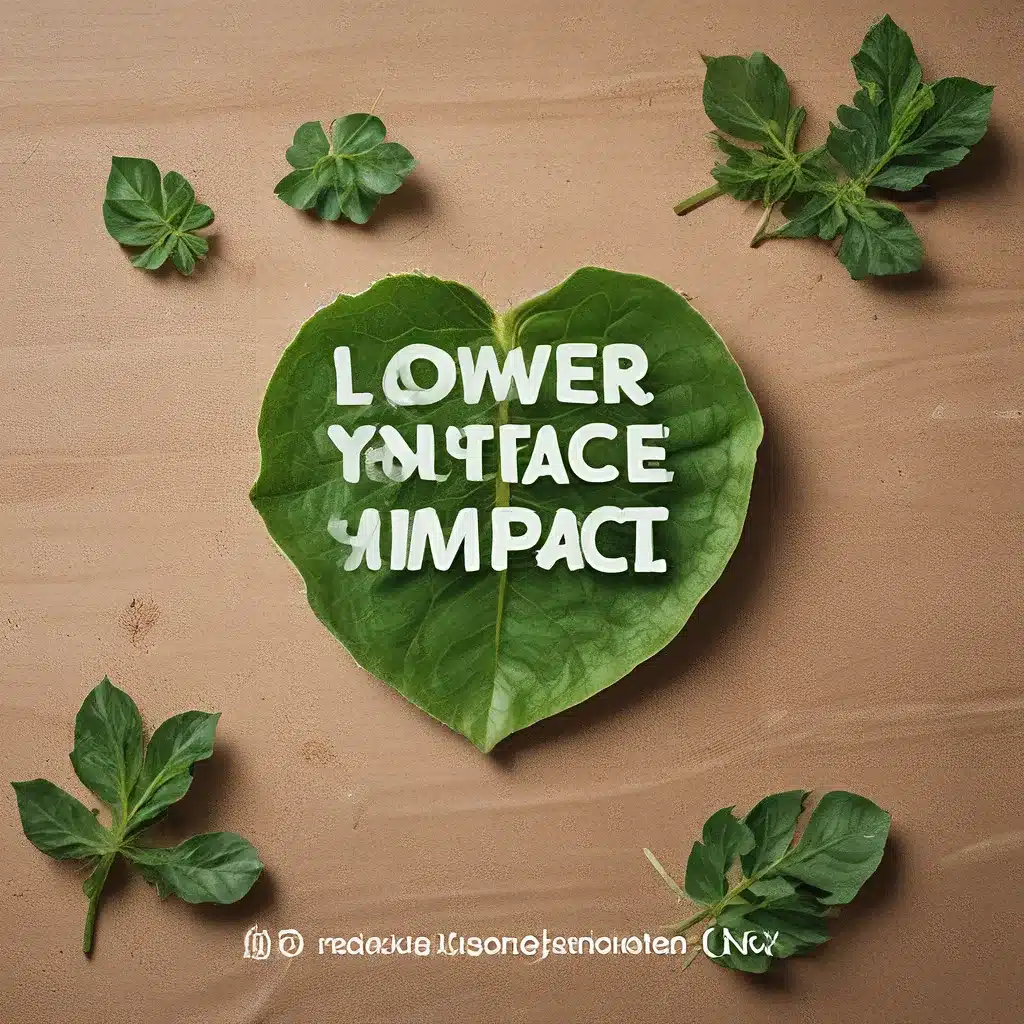
A Wake-Up Call for My Lazy Lifestyle
I’ll admit it – I’m a bit of a slacker when it comes to living sustainably. I mean, I recycle and all, but beyond that, my eco-friendly habits have been, well, lacking. It’s just so easy to fall into a pattern of convenience, you know? Grab a plastic water bottle here, order something shipped in a mountain of packaging there. But lately, I’ve been feeling the weight of my environmental footprint, and it’s time for a change.
You see, I was browsing the website for this awesome custom sofa company in the UK called Sofa Spectacular, and they had this article all about living more sustainably. It really got me thinking – what more can I be doing to lower my impact and make a positive difference?
As it turns out, quite a lot. From cutting down on plastic waste to rethinking my diet, there are so many simple swaps I can make in my daily life. And the best part? Not only will it be better for the planet, but it can also lead to a more fulfilling, intentional way of living. Who would’ve thought?
Kick the Plastic Habit
Ah, plastic. That ubiquitous material that’s taken over our lives, from the water bottles we sip to the straws that come with our iced coffees. But here’s the thing – plastic never goes away. In fact, at least 14 million tons of it end up in our oceans every year, where it makes up a staggering 80% of all marine debris.
And the consequences are devastating. Thousands of seabirds, sea turtles, seals, and other marine life are killed each year after ingesting or getting tangled up in plastic waste. It’s a heartbreaking sight that really drives home just how much our plastic addiction is hurting the planet.
So, what can we do about it? Well, the solution is actually pretty simple: ditch the single-use plastics whenever possible. Swap out those plastic water bottles for a reusable one, say no to straws, and opt for unwrapped produce at the grocery store. Every piece of plastic you avoid is a win for the environment.
It may take some getting used to at first, but trust me, it becomes a whole lot easier once you start seeing the impact. Plus, you get to feel a little smug every time you turn down that plastic straw. It’s a win-win, really.
Embrace a Greener Plate
Now, let’s talk about another area where we can make a big difference: our diets. As it turns out, the meat and dairy industry is one of the most environmentally destructive industries out there, responsible for massive amounts of water use, pollution, greenhouse gas emissions, and habitat destruction.
I know, I know – the thought of giving up my beloved cheeseburgers and ice cream is enough to make me want to cry. But hear me out. By choosing to eat more plant-based foods and reducing my meat and dairy intake, I can significantly shrink my environmental footprint.
And it’s not just about the animals and the planet – there’s a personal benefit, too. Food waste is a huge problem, with nearly 40% of all edible food in the United States going to waste. By being more mindful about the food I purchase and consume, I can cut down on waste and save myself some money in the process.
So, how do I get started? Well, it’s all about finding delicious, satisfying plant-based alternatives that tickle my taste buds. Maybe I’ll swap out my usual beef tacos for some lentil or black bean ones. Or I could try my hand at making a creamy cashew-based mac and cheese. The options are endless, and with a little creativity, I bet I can find some new favorite dishes that are both good for the planet and good for me.
Rethink Celebrations and Holidays
Ah, the joys of holidays and celebrations – the gifts, the decorations, the mountains of single-use plates and cups. But let’s be real, all of that excess is doing a number on the environment.
I mean, think about it – in December alone, Americans create 23% more waste than in other months of the year. And it’s not just the extra trash that’s the problem. All the fossil fuels, trees, and other natural resources that go into producing those gifts, decorations, and disposable party supplies make our celebrations pretty dreary for the wildlife and habitats that need them to survive.
But you know what? We can redefine the way we celebrate in a way that’s way more fun and a whole lot better for the planet. Instead of reaching for the plastic baubles and gift wrap, I can decorate with foraged plants and give homemade or secondhand gifts. And instead of serving up meals on a sea of disposable plates, I can use my trusty reusable dinnerware.
It may take a bit more effort, but I guarantee the end result will be just as joyful – if not more so. After all, the true spirit of the holidays isn’t about the stuff, but about the connections we make and the memories we create. And what better way to honor that than by celebrating in a way that respects the natural world?
The Power of Organic and Secondhand
I’ll be the first to admit that I’m a bit of a sucker for fast fashion. There’s just something so satisfying about snatching up the latest trends at bargain-basement prices. But the truth is, that cheap thrill comes at a heavy cost – both for the environment and for the people who make those garments.
The fashion industry is a massive contributor to the climate crisis, responsible for up to 10% of global carbon emissions. And that’s not even touching on the water pollution, habitat loss, and other harms caused by the production of animal-based textiles like wool.
But fear not, there are plenty of ways I can satisfy my sartorial cravings while lightening my environmental load. Firstly, I can slow down my fashion consumption by caring for the clothes I already have, repairing them when possible, and shopping secondhand or joining clothing swaps when I do need something new.
And when I do need to buy new, I can look for truly sustainable materials like organic cotton or Tencel, and support brands that are committed to ethical and eco-friendly practices. No more falling for the greenwashing – I’m going to be a savvy, conscious consumer.
But it’s not just clothes where I can make more sustainable choices. The same goes for the food I buy, the products I use, and even the way I garden. By choosing organic, I can reduce my exposure to harmful pesticides and support farming practices that are kinder to the land, the wildlife, and the communities that depend on it.
And when it comes to gardening, I can ditch the chemical sprays and instead create a thriving oasis for beneficial insects and other critters by growing native, pollinator-friendly plants. It’s a win-win for me and Mother Nature.
Saving Water and Cutting Emissions
As if plastic, food, and fashion weren’t enough, there are a few other areas where I can make some meaningful changes to lower my environmental impact.
First up, water conservation. With our growing population and the threat of unprecedented droughts, preserving our precious water resources is more important than ever. And the good news is, there are plenty of simple ways I can do my part, like taking shorter showers, fixing leaky toilets, and choosing low-flow appliances.
Oh, and let’s not forget about that water-guzzling animal agriculture industry. By shifting my diet away from meat and dairy and opting for more plant-based options, I can save a significant amount of water while also shrinking my carbon footprint.
Speaking of carbon, let’s talk transportation. Those fossil-fueled vehicles we rely on so heavily are a major source of greenhouse gas emissions, not to mention all the air pollution they create. But by making some adjustments to my driving habits, I can dramatically reduce my environmental impact.
Walking, biking, carpooling, or using public transportation whenever possible is a great start. And when it comes time to upgrade my ride, I’ll definitely be considering an electric vehicle. Not only are they better for the planet, but they can also save me money in the long run.
And let’s not forget about my home itself. By making sure it’s properly insulated and equipped with energy-saving windows, programmable thermostats, and efficient lighting, I can seriously slash my energy usage and utility bills. Plus, if my state allows me to choose my electricity supplier, I can opt for one that generates a good chunk of its power from renewable sources like wind and solar.
Protecting Wildlife and Speaking Up
As I’ve learned, our individual actions have a bigger impact than we might think. But the truth is, we can’t do it all alone. It’s going to take a collective effort to tackle the environmental challenges we’re facing.
That’s why it’s so important to get politically involved, both in our local communities and at the national level. By voting for candidates with strong environmental platforms and urging our representatives to pass stronger policies to protect wildlife and address climate change, we can create real, lasting change.
And it’s not just about voting – we can also use our voices and our wallets to make a difference. Signing action alerts, attending events, and donating to organizations fighting to end the extinction crisis are all powerful ways to get involved.
After all, the fate of countless plant and animal species hangs in the balance. From the endangered bluefin tuna to the countless other creatures threatened by habitat loss, unsustainable resource extraction, and the wildlife trade, we have a responsibility to speak up and take action.
At the end of the day, our individual choices and collective efforts can make a world of difference. By lowering our environmental impact and living more sustainably, we don’t just safeguard the planet for future generations – we also create a more joyful, fulfilling way of life for ourselves.
So, who’s ready to join me on this journey towards a greener, more sustainable future? Let’s do this, for the sake of our beloved home and all the incredible creatures that call it home.



